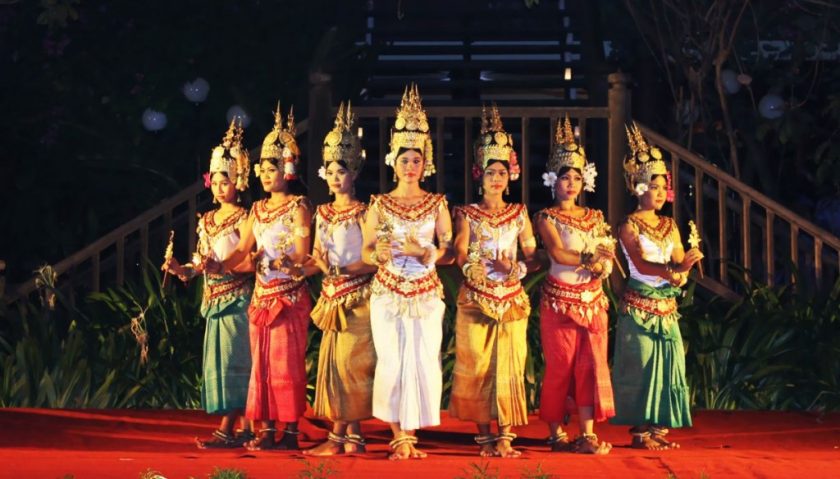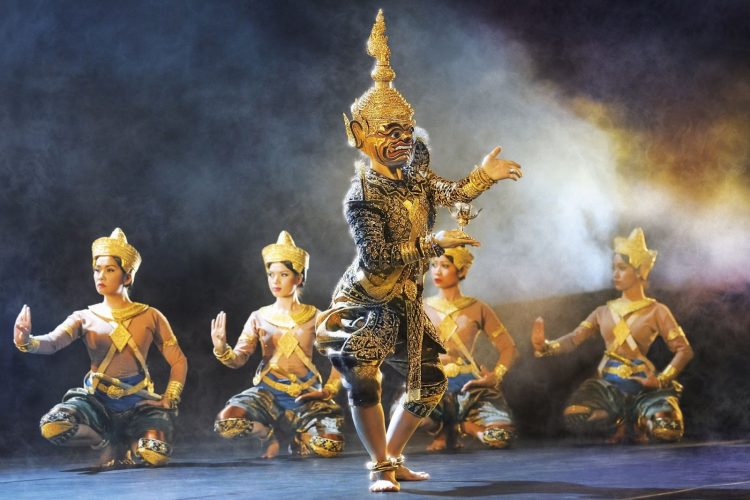Apsara Dance: A Sneak Peek of Khmer classical dance
The Apsara dance, originating from the rich cultural heritage of Cambodia, embodies elegance, grace, and divine beauty. Recognized worldwide for its mesmerizing hand movements and exquisite costumes, the Apsara dance has captivated audiences for generations. Rooted in ancient Indian mythology, the Apsara dance tells stories of celestial spirits descending from the heavens to entertain gods and kings. Over the years, it has evolved into a symbol of Khmer culture, earning recognition from UNESCO as ‘Intangible Cultural Heritage’. Through rigorous training and intricate choreography, Apsara dancers bring to life the soulful expressions and history of Cambodia, creating a spellbinding experience for all who witness it.

Origin and Mythology
The Apsara dance finds its roots in ancient Indian mythology, where Apsaras, meaning ‘water nymphs’ or ‘celestial spirits’, were divine beings known for their enchanting dance and charm. According to legend, these celestial maidens descended from the heavens to entertain gods and kings with their graceful movements. This mythological narrative is deeply ingrained in South and Southeast Asian history, as evidenced by ancient Hindu and Buddhist texts and artworks, particularly those found in Angkor Wat.

The Apsara dance we know today was inspired by these mythological tales and historical artwork. Queen Sisowath Kossamak, during a visit to a local primary school in the 1940s, was moved by children mimicking Apsara movements depicted on the walls of Angkor Wat. This inspired her to revive the ancient dance form, making it a personal passion. Her granddaughter was selected to pursue a professional dance career at a young age, becoming the modern era’s first Apsara dancer.
Revival and Modern Era
The revival of the Apsara dance in the modern era marks a significant cultural resurgence and transformation. Once reserved exclusively for the royal family and elite members of society, the Apsara dance underwent a revival that democratized its accessibility and elevated its status to a symbol of Khmer culture on the global stage.
In the mid-20th century, efforts spearheaded by Queen Sisowath Kossamak led to the revitalization of this ancient art form. Inspired by the graceful movements of children imitating Apsara depictions at Angkor Wat, the Queen embarked on a mission to ensure the preservation and propagation of Cambodian traditional dance. Through her patronage and encouragement, young talents were nurtured, and the Apsara dance was reintroduced to Cambodian society.
The modern era witnessed the Apsara dance transcending its aristocratic origins to become a cherished cultural treasure accessible to all. With the establishment of dance schools, cultural institutions, and performance troupes, the Apsara dance flourished, captivating audiences worldwide with its elegance and sophistication.

Moreover, the designation of the Royal Ballet of Cambodia as UNESCO’s ‘Intangible Cultural Heritage’ in 2003 solidified the Apsara dance’s status as a national emblem and global cultural heritage. This recognition not only honored Cambodia’s rich artistic legacy but also safeguarded the Apsara dance for future generations, ensuring its enduring legacy in the annals of history.
Training and Techniques
Mastering the Apsara dance demands rigorous training and impeccable technique, reflecting centuries of tradition and cultural refinement.
Training typically commences at a tender age, often before reaching double digits, and extends over a decade, sometimes more. Central to this arduous process is the development of leg strength to execute intricate movements and the cultivation of hand flexibility to articulate every gesture with precision.
Apsara dancers undergo meticulous instruction in posture, movement, and expression, guided by seasoned mentors who impart their knowledge and expertise. The training regimen encompasses a myriad of exercises, from stretching and conditioning to choreography rehearsals and artistic interpretation.

The hallmark of the Apsara dance lies in its languid, ethereal movements, reminiscent of celestial beings gliding through celestial realms. Each gesture, from the subtle flick of a wrist to the gentle arch of a foot, conveys profound symbolism and narrative richness, evoking the essence of Cambodian folklore and mythology.
Moreover, the Apsara dance transcends mere physicality to embody spiritual and cultural dimensions, requiring dancers to internalize the essence of Khmer heritage and channel it through their performance. Thus, training extends beyond the realm of physical technique to encompass a deep understanding of tradition, mythology, and cultural symbolism, ensuring that each dancer becomes a custodian of Cambodia’s artistic legacy.
Costumes and Performances
The allure of the Apsara dance is not only in its graceful movements but also in the stunning costumes that adorn the performers, adding a visual spectacle to the mesmerizing performance.
Traditional Attire:
Apsara dancers don intricately crafted costumes inspired by the bas-relief carvings of Angkor Wat, the iconic temple complex in Siem Reap. These costumes typically consist of a flowing silk skirt adorned with intricate patterns, a bejeweled golden headdress, and an array of accessories including collars, armlets, bracelets, anklets, and earrings.
Each piece is meticulously designed to evoke the grandeur of Khmer royalty and the celestial beauty of the Apsaras.
Symbolism:
The attire worn by Apsara dancers holds symbolic significance, reflecting themes of divinity, elegance, and cultural heritage. The elaborate headdresses and ornate jewelry symbolize the celestial origins of the Apsaras, while the flowing silk skirts evoke a sense of ethereal grace and fluidity in movement.
Performance Venues:
Apsara dance performances can be witnessed in various venues across Cambodia, ranging from cultural institutions to luxury cruises along the Mekong River. In Phnom Penh, the National Museum and several restaurants host nightly performances, allowing visitors to immerse themselves in the beauty of this ancient art form.
Additionally, luxury cruise operators like Heritage Line offer open-air galas featuring Apsara dancers, providing passengers with a unique opportunity to experience the magic of the Apsara dance against the backdrop of the majestic Mekong River.
Best Places to Watch Apsara Dance
In Cambodia, you can enjoy the traditional Apsara dance in various stunning locations that showcase the rich cultural heritage of the Khmer people.
- Siem Reap: Known as the entrance to the Angkor temples, Siem Reap is a top spot to experience Apsara dance. Guests can watch the captivating performances while dining at Khmer restaurants, creating a memorable cultural experience.
- Apsara Terrace At Raffles: Located in the luxurious Raffles Grand Hotel d’Angkor, the Apsara Terrace offers enchanting nightly performances in a traditional Khmer setting. Guests can enjoy Khmer cuisine while watching graceful Apsara dancers.
- Fou-Nan: Situated in Siem Reap, Fou-Nan Restaurant offers authentic Cambodian cuisine accompanied by live Apsara dance shows. Diners can savor Khmer food while admiring the beauty of the traditional dance.
- Temple Balcony: Some venues in Siem Reap feature Apsara dance shows on temple balconies, providing a unique cultural experience against the backdrop of ancient ruins.
- Smile Of Angkor Wat: This show in Siem Reap presents Cambodian history and mythology through mesmerizing Apsara dance performances, showcasing the beauty and grace of the traditional dance and leaving a lasting impression of Cambodia’s cultural heritage.
In conclusion, witnessing the spellbinding Apsara dance is an essential part of any visit to Cambodia. Its unique beauty and cultural significance make it a must-see experience for travelers seeking to immerse themselves in the rich heritage of Khmer culture. Don’t miss the opportunity to marvel at the elegance and grace of this traditional art form firsthand.
Relate blog
Relate blog

Quan Lan Island in Quang Ninh Province is a magnet for travelers seeking beautiful beaches, serene surroundings, and crystal-clear waters….

Nguyen Hue walking street in Ho Chi Minh City is a vibrant hub that beckons both tourists and locals. As…

The five elements-inspired Non Nuoc Mountains, also known as Marble Mountains, consist of six limestone peaks covering an area of…

